Europe 2000: Switzerland and Portugal
Fri Sep 9, 2000: San Francisco to France
A long flight... I'm glad that I slept most of the way. Later, I learned
that the DC-10 plane in which I flew (flight 55 from Newark-CDG) is the
one that lost a metal strip a few months earlier that may have caused the
crashing of the Concorde on July 25th, 2000.
Sat Sep 10: France to Geneva
|
Woke up just before landing. The nice person seated next to me saved a
breakfast tray for me. However, we were landing 3 hours behind schedule.
This was allowing me only 1 hour before the connection with the TGV (at
Gare de Lion) to Geneva. So much for my plans to leisurely go to the train
station! I zoomed through immigration and customs (good that I had a
carry on only) and went to the RER station at the airport. You don't
realize how far the airport is from Paris until you are in a hurry. At
one moment, I was sure I was going to miss the train, but I was able to
arrive a minute and a half before departure! Plenty of time to
spare...
After 4.5hrs, I arrived to Geneva. Nice city by the lake with good
views of Mt. Blanc. I spent the late afternoon walking around the
promenade around the lake. In the lake, there is a gigantic fountain,
the Jet d'eau. The Jet d'eau is truly impressive: a 140m column of water
that it's visible everywhere. I tried to contact my friend Jarek, but he
was away taking art classes in Florence. In Geneva I stayed in the
HI Youth Hostel. The Youth Hostel was ok, with rooms for 8 people (4 bunk
beds). It was reasonably clean and it served a "cafeteria" dinner for 14
swiss francs. The Youth Hostel is very close to the edge of the lake and
getting to old city is a pleasant 15-minute walk.
|

Lake Geneva

Jet d'Eau
|
Sun Sep 11: Geneva, Lausanne, Chillon Castle, Montreux
Geneva
I spent the morning touring the major attractions of Geneva. The old
medieval town is quite nice, but the cathedral was a disappointment.
Outside it looks good, but the reformation left the interior of the
cathedral with the charm of a warehouse. The baptistery was supposed to
be nice, but it was closed because of Sunday baptisms.
Geneva was the center of the Calvinist Reformation, and at one time it was
known as the "Protestant Rome".
|

Monument to the Reformation
|
Lausanne
From Geneva, I took the train to Lausanne. This is a nice small town that
it's extremely hilly. A convenient "subway" system allows to climb to the
top of the town from the train station and down to the lake shore. In
Lausanne, I visited the Cathedral (much better than Geneva, impressive
stained glass windows), the Eglise Saint-François, and had a nice stroll
through the medieval town.
|
 Eglise Saint-François
Eglise Saint-François
|
 Cathedral of Lausanne
Cathedral of Lausanne
|
Boat ride in Lake Geneva
From Lausanne I took the boat to Château de
Chillon. The boat was 45mins late (I thought everything was on-time in
Switzerland), but it was worth it. It was a paddle wheeler built on 1915
called Savoyans. The engine was all exposed and it was fun to see
(and feel) the power of the boat.
|
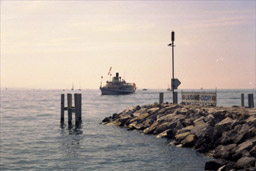
The Savoyans approaching Lausanne-Ouchy

View from the lake

The engine of the Savoyans.
|
Château de Chillon.
The Chillon Castle was very nice (specially the ramparts). The brochure
in Spanish was excellent (there was an English one also available).
From Chillon,
I walked the 45 mins lake-shore
trail back to Montreux which is a nice, touristy town by the lake. From
Montreux, I went back to Geneva (this was a mistake, I should have stayed
in the youth hostel there, so I would have cut 1hr of my travel time the
next day). In Geneva I stayed in the Geneva HI Youth Hostel again.
|

Château de Chillon and highway

Ramparts

View from the tower
|
Mon Sep 12: Three countries in one day: Chamonix (F), Hellbronner (I),
Martigny, Valais, and Leukerbad (CH).
|
I woke up in perfect weather, so I decided to go to Chamonix, France.
I took the train to Martigny and connected with the narrow-gauge
Mont Blanc express. This is an awesome ride with excellent views
of the mountains. The train goes from valley to valley until it gets
to Chamonix. To climb the steep hills in between valleys the trains
uses a cremaillere.
|

A station in the line Martigny-Chamonix

Train Martigny-Chamonix (Mt. Blanc Express)
|
|
Chamonix is a nice town, but I decided to go to the mountain as soon as
I could. I took the cable car to Aguille du Midi, the elevator to the
top, and the gondola to Hellbronner (Italy) over the Mer de Glace (the
gondola is called Panoramic du Mont-Blanc). Of all this, the best
part by far is the ride to Hellbronner. For 45mins, you are alone in a
gondola suspended high above the glacier. You are treated to amazing
views of Mont Blanc and the surrounding peaks. You can see down to the
glacier and be amazed by the crevasses, and you can even spot the
hundreds of climbers that are walking on the glacier or up Mont Blanc.
Hellbronner is the highest border station in Europe, but there is
nobody there to stamp your passport. There is no much to do in
Hellbronner. What is worth is the ride there.
|

Mt. Blanc

The Swiss Alps

At the terrace of Aguille du Midi

Mt. Blanc climbers

The French Alps
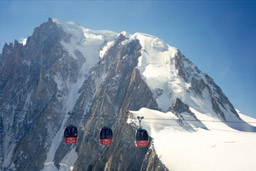
Panoramic du Mont-Blanc

Mer de Glace
Crevasses and Route


On a safe area of the Mer de Glace

I'm in Italy!

Hanging Pole and Aguille du Midi

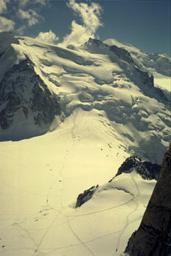
Route to Mt. Blanc

Chamonix from Aguille du Midi

Ice tunnel
Starting point to climb Mt. Blanc
|
|
Back to Chamonix, I toured the town. The crowd that the town attracts
is very interesting, ranging from the typical American tourist with
Hawaiian shirts to seasoned climbers. No doubts that Chamonix is
climber's paradise, half of the stores sell postcards and t-shirts
(for the American tourists), but the other half sell carabiners, ropes,
and crampons.
|

Chamonix
|
Martigny
From Chamonix, I headed back to Switzerland and the town of Martigny.
Believe or not, the man with a bull head is about all that it's to see in
Martigny (unless you have a car and you go to the Roman ruins). Not
having much to do in that town (and my connection to Leukerbad not due for
another 2hrs), I decided to catch the next train to Sion
|

Martigny
|
Sion
I didn't have much time, but at least I walked in the
old town of Sion and went to the parliament with its impressive clock.
Sion also looks very impressive in the distance, with two hills crowned
each by a castle. I finish this long day by taking the train to Leuk
and then the postal bus to Leukerbad, where I check in in Hotel Derby.
|

Sion Castle
|

Valais canton seat
|
Tue Sep 13: Leukerbad and the Daubenhorn Klettersteig.
|
The big climbing day finally arrived! I woke up early to catch the
first cable car to Gemmi Pass. From there, it was an easy 20min
downhill hike to the start of the via ferrata (or klettersteig in
German). The klettersteig is setup in a 980m wall and it took me about
6.5hrs to climb it. The climb was set up very nicely, so it was always
in the 5.0-5.4 range. Something nice was that there was no additional
hardware (except for the safety cable) where natural features were
available. In the places where it was harder than 5.4, there were
pitons that you could step on, or even ladders (slightly overhanging
ladders were a lot of fun). Take a look at this webpage for a
description of it. Unfortunately, I broke my camera half way up, so I
only have a few pictures :-(
During the climb,
there were some soldiers shooting with machine guns and artillery in a
nearby peak. During lunch time they took their meal out of the mess
tent and they start cheering me (either that or they were warning me
that a bomb was about to fall on my head). It was a lot of fun to hear
the reaction of the soldiers every time that I finish a traverse or got
to a ladder.
At the top of Daubenhorn, the view was awesome and I
could
see all the way to Mont Blanc; but I was confronted with the problem
that
I have no clue how to go back to Leukerbad. I follow a use trail that
was going in the right direction, but it ended at the edge of
a glacier. I didn't feel like crossing a glacier just by myself, so I
started following the edge of the glacier. I didn't know that the
glacier ended as a hanging glacier and a waterfall. It took me some
climbing and backtracking until I was able to find a place where I could
safely cross the big stream coming out of the glacier. Then, I have to
climb up a big and steep lateral moraine, until I got to gentle terrain
that took me back to Gemmi pass. Because of all the backtracking, I
missed the last cable car for about 20mins, so I have to walk all the
way down to town (about 1.5hrs). Everything looked closed in Leukerbad,
but
the hotel manager sent me to a pizza place that closes late so I was able
to have something
for dinner.
|

Daubenhorn (left)

A typical segment of the Klettersteig

Airy!

Ladder

Maximum exposure (500m?)

Leukerbad

Series of ladders

Half way in the ladder

Swiss flag

Half way point (end of "easy" part)

Towards the top
(this is actually a false summit)

Self portrait

Death of my camera
|
Wed Sep 14: Leukerbad To Zermatt
|
Leukerbad is an interesting town. The town is known for its thermal
bads and attracts a crowd of old people who go there because of the
therapeutic properties of the water. The average age of the visitors
in the town was probably 80 years old. I've never feel so young in my
life. I thought of "taking the waters" and I got a brochure where I
found a "wellness regime" which looks pretty good to me. However,
when I read the details, it turn that was indicated for people
"recovering from psychological problems or diseases of the mind." I'm
still on denial, so I decided to skip it and instead I went to Zermatt.
The ride to Zermatt is beautiful. The ride from Leukerbad to Leuk in
the postal bus (which I did in the dark in the way there) is just
awesome.
BTW, postal buses in Switzerland have the right of ways no matter what.
People will back up at high speed to get out of the way of the postal
bus when they hear the horns played by the bus (which sounds like a
charging march).
From Leuk, I went to Brig, and from there to Zermatt. Again, the ride
from Brig to Zermatt (one of the legs of the Glacier express) was just
incredible. Switzerland is a country where travel time is not dead
time, the views from the train are almost always awesome.
In Zermatt, I took the cable car to Sunnega, and did a nice hike from
there to Riffelalp. This hike took me through a series of lakes with
nice views of the Matterhorn at all times. I visited Leisee, Stellisee,
Grindjisee, and Gruensee. A very nice hike, although the Mirages and
F-18 flying and chasing each other in the air was an annoyance.
When I got to Rifflealp, it was still early, so I decide to walk down
to Zermatt, instead of taking the Gornegrat train. The walk down was
very enjoyable, with more views of the Matterhorn, and many swiss
traditional houses surrounded by cows.
In Zermatt I slept in Hotel Garni Cima.
|

Train to Zermatt

Lunch spot

Matterhorn reflection on Leisee

Hiking in the alps

Mountain Hut Fluhalp with Monte Rosa (4834m) in the background

Stellisee, Mountain Hut Fluhalp, and Monte Rosa

The start of Fall colors

Near Findelnbach

Zermatt with Matterhorn in the back

In Zermatt

Zermatt's church

Street in Zermatt

Gornegrat train

Hotel Garni Cima
|
Thu Sep 15: Zermatt to Grindelwald, Jungfraujoch
|
I got early and had breakfast (the best in the trip). Originally I
was thinking of staying longer in Zermatt, but I couldn't find an
interesting hike, so I decided to move on to Grindelwald.
In Grindelwald, the weather was perfect, and following the advice
from my guidebook, I just went to Jungfraujoch. The trip up there
is extremely expensive (CHF 137, 25% off with the swiss pass); but
it's more than worth it in good weather.
The train take you (very slowly) to Gross Scheidegg. This is not a
very nice place. Just a huge hotel and stores and hundreds of
tourists. The view makes it better, but for some reason, I couldn't
stand the place. From there, another train takes you inside the Eiger
to the "Top of Europe" in about 50 minutes.
From Gross Scheidegg, the heads up the hill through snow sheds until
Eigergletscher is reached after about 10 minutes. During these 10 minutes
the scenery is breathtaking as the train climbs up in the shadow of the
Eiger, Monch, and the Jungfrau. The ice of the Eiger Glacier becomes
visible and glistens in the sunshine even though this old ice is coated in
a dusting of atmospheric pollution giving dirty black shading to the ice.
From Eigergletscher, the train enters the forbidding tunnel through the
storm doors and proceeds slowly up the gradient. This section is boring
but is relieved by short sightseeing stops at Eigerwand and Eismeer tunnel
stations respectively. Eigerwand is a tunnel station stop behind the
north wall of the notoriously infamous Eiger. From here there is a
breathtaking view over Grindelwald and Kleine Scheidegg that is beyond
belief. Only a climber on the North face may share this view. It is a
unique experience, but if you feel that you want to get out, there are
doors to the outside for people who want to do ice climbing. It was fun
to see the slow progress of the climbers below
The next stop around the corner is Eismeer. It is a window looking out
over a snow and ice field with contrasting dark colored mountains
ruggedly and sharply rising in the background. It is silently eerie and
awesome.
The stops at Eigerwand and Eismeer are awesome, so make a point to leave
the train. Each stop lasts about 5 minutes and they won't leave without
you.
Slowly, eventually, the train arrives at the underground station at
Jungfraujoch.
At the "Top of Europe" there is a lot to do. I went to the
Observation Deck and enjoy the view of Jungfrau, the Monch, and Eiger.
These are in English the Young Lady (or Virgin), the monk, and the troll.
To remember the order of the peaks, the locals use the phrase: the young
lady is protected by the monk from the troll.
A particular attraction is the ice palace, where passages are carved out
of the glacier ice with ice sculptures inside. The place was a lot of fun
and one can see the different layers of the glacier as well as the debris
that the glacier is carrying. Outside, there there is a "safe" corridor
on the glacier with a hotel at the end of it (50mins walk). There are
also free snow disks that allow one to slide through another safe corridor
in the glacier. There was also a ski lift, but the equipment and ticket
was 30 CHF and the thing didn't look very exciting (I would rate it as an
easy green). I also went to the museum that explains how the tunnel of
the Eiger was built (very nice museum) and to a movie about the Top of
Europe (just a very boring infomercial). I got back late at night to
Grindelwald, where I stayed in Hotel Tschuggen.
|

Towards Grindelwald

Grindelwald-Gross Scheidegg train

North face of Eiger

North face of the Monch
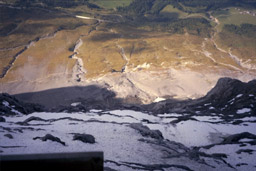
Down the north face of the Eiger
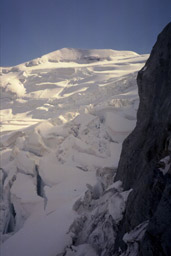
Up the East face of the Monch

The door to the outside

On the Observatory (The Monch at the back)

On the Observatory (The Monch at the back)

On a safe area of the Jungfrau glacier

Inside the Jungfrau glacier (The Ice Palace)

Slippery ice chair

Panoramic of the Jungfrau glacier

Sunset on the Monch and Jungfrau
|
Fri Sep 16: Grindelwald to First, Klettersteig Schwarzhorn, Kleine
Sheidegg, Bern
|
I went to the tourist office and asked them for a good hike in the
area. They recommended the First area and give me a free hiking map.
When reviewing my options, the word "klettersteig" caught my eye. I
guess I didn't get enough of climbing, so I decided to do it.
After getting to First (yes, I'm not kidding, the place is called
First), I hike about 1hr to get to the bottom of the klettersteig. This
was at a saddle in between two steep walls. The klettersteig turned to
be quite short and much easier than the one in Leukerbad, but still, one
gets a lot of exposure. After the klettersteig, I hike down to the
small village of Kleine Sheidegg where I took the postal bus back to
Grindelwald. At Grindelwald, I took the train to Interlaken and from
there to Bern where I arrived around 6pm. At Bern, I stayed with the
parents of my friend Louis. Louis' parents where the best hosts ever.
They invited me for dinner and took me around for the time that I was
there. I would have never been able to explore the Bern area as well as
I did without their hospitality.
|
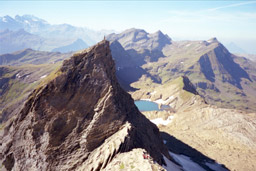
Halfway in the Schwarzhorn klettersteig

Schwarzhorn klettersteig

At the top

Cows
|
Sat Sep 17: Bern, Murten, Avenches
Bern
Louis' father took me for a tour of the city. Bern is probably the
friendliest capital city I've visited in Europe. It's small, clean, quiet,
and full of attractions reachable by a convenient public transportation
city.
Don't miss the medieval part of the city. In that area, the streets have
covered walkways that invite for a leisurely window shopping. The covered
walkways also make the city convenient in case of rain (like when I was
there). There are fountains that once provided the municipal water supply
every block or so in the main streets. These fountains can be quite
elaborated and colorful. On the main street, you will also find the
"famous" clock tower. It's amazing that the clock have been performing
since the 16th century. But, even more amazing than that is the crowd
that forms to watch the slow motion show that starts 4 minutes before each
hours. In my opinion, the clock may have been impressive 300 years ago,
but today it's not such a great deal.
I also visited the Bear Pits. It's kind of sad to see four nice brown
bears trapped in the pits. It's even sadder when you learn that those
bears are extinct in Switzerland and there are only between 130 and 200
bears living in the wild in all Western Europe (mostly in France, Spain,
and Italy). Fortunately, there are 35000 bears west of the Urals in
Russia, and there are some plans for reintroducing the bear in Western
Europe. To say something positive about the pits, there are quite big
(for a zoo) and the bears have plenty of "toys" to entertain
themselves. According to Louis' father, it hasn't been always like that.
The fascination for Bears in Switzerland comes from the fact that the
bear is the symbol of Bern and is found on the canton's flag. According
to the legend the name Bern was given to the city by Duke Berchtold V of
Zähringen after a hunt held in the wooded surroundings of his new town
in which his first prey was a bear.
|

Bear pits

Bern main street

View from Cathedral

View from Cathedral

A fountain in Bern
|
Murten
Louis' father took me to the town of Murten. This is a beautiful medieval
town of about 4500 people.
The ramparts of Murten played an important role in one of the biggest
battles leading to the formation of the Swiss nation. Five hundred years
ago, Charles the Bold, Duke of Burgundy, laid siege to this town. But the
people of Murten, from these walls, held off his huge army for two and a
half months. Finally, the Swiss Confederate Army arrived; they trapped the
Burgundians between here and the lake. Eight thousand Burgundians
died, dyeing the waters of the lake red with blood.
Today, an algae occasionally grows more than usual and turns the water
red. Legend says that that's the blood of the Burgundians.
I was very impressed and surprised by the Swiss wine. I didn't even
know they made it until Louis' parents served some to me. We stopped at a
winery in the Jura region and enjoy some of their wines.
|

From the ramparts of Murten

Murten and the lake
|
Avenches
I bet when you think Switzerland, you don't think about Roman ruins. But
the quiet little town of Avenches is a reminder that this valley was an
important crossroads during Roman times. It flourished for over 200
years, until it was destroyed in 259 AD. As the capital of this chunk of
the Roman Empire, the ancient city was much larger and livelier than it is
today. You can see from the excavations surrounding Avenches, how much
bigger the Roman city actually was.
The Swiss haven't forgotten their Roman Heritage. In fact, the "CH" on
the cars doesn't stand for chocolate. That's Confederation Helvetica, the
original Roman name for Switzerland.
|

Roman coliseum
|
Dinner with Louis' parents
Back to Bern, Louis' parents treated me to a great dinner. They
prepared a wonderful fondue for dinner :-)
|

Dinner with Louis' parents.
|
Sun Sep 18: Bern->Paris, Paris, Lisbon
Paris
I took an early morning TGV to Paris. I arrived Paris and I had a few
hours to kill before my flight to Lisboa, so I just walked around the
champ Elysee and went to the top of Eiffel Tower.
|

I'm in Paris!

The Seine and Eiffel tower

From the top of the Eiffel Tower

The Seine
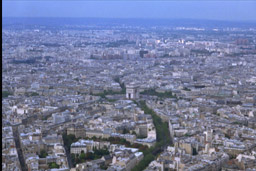
Arch de Triumph

At the top of the Eiffel Tower
|
Thu Sep 22: Lisbon
|
In Lisboa, I visited the Monasterio dos Geronimos, the Belen tower, and
took a river cruise.
|

Monasterio dos Jeronimos

Monasterio dos Jeronimos

Belen Tower

Portuguese Flag

Vasco da Gama Bridge

Boat by Vasco da Gama Bridge

Lisbon Cathedral

Commerce Square in Lisbon

25th April Bridge

Monument to the discoverers

Belen Tower from the Tagus River (Rio Tejo)
|
Fri Sep 23: Nazare, Alcobaça, to Madrid
Nazare
The cute little town of Nazare couldn't be so much of a pleasure to
see. It is actually two towns in one. The low town (by the ocean) and
the high town (at the cliffs). To go from one to the other, one takes a
cable car (elevador). The cable car is more than 100 years old and it
was build by a person with the same last name as me (family? I don't
know).
|

Nazare low town

Nazare high town

Cable car that connect low and high town
|
Alcobaça
This abbey church, the best Gothic building and the largest church in
Portugal. It's a clean and bright break from the heavier Iberian norm. It
was started in 1178 after this area was reconquered from the Moors. It
became one of the most powerful abbeys of the Cistercian Order and a
cultural center of 13th century Portugal.
The church contains the tombs of Dom Pedro I and Dona Ines de
Castro. The story of this couple is worthy of a soap opera. Pedro, heir
to the Portuguese throne, was married to a Portuguese lady. This was an
arranged marriage and Pedro didn't love his wife. Instead, he was in love
with his wife's lady-in-waiting, a Spanish aristocrat called Ines.
Pedro's wife died without producing a heir, given Pedro the opportunity to
marry Ines. However, Pedro's father, Alfonso IV, forbade his son to marry
Ines out of concern about Spanish influence. The relationship between
Pedro and Ines was despised by the royal court, so in the interest of
Portuguese independence (and under a lot of pressure from the Portuguese
nobles), King Alfonso IV had Ines murdered. What the king didn't know was
that Pedro and Ines had already married secretly. When Pedro became king
(1357), he ripped out and ate the hearts of the murderers of Ines. And,
he had Ines' rotten corpse exhumed, crowned it, and made the entire royal
court kiss what was left of her hand.
Pedro and Ines are resting feet-to-feet in each transept, so that on
Judgment Day they'll rise and immediately see each other again.
|

Monastery of Alcobaça

Inside the church of Alcobaça

Tomb of Dom Pedro
|
Sat Sep 24: Lisboa->Madrid->USA
Uneventful. A very long day.
Learnings:
- If you are traveling in Switzerland, the Swiss Pass is a good
deal. For 320 swiss francs (2nd class) you get unlimited travel for 8
days in all trains (even private ones), postal buses, boats, and city
public transportation; you also get 25-50% discount on cable cars. I
probably would have spent close to 500 swiss francs without the pass.
- Youth hostels are not a good value in Switzerland. If you are
traveling in a shoestring, then use then, but if you have an extra $10,
then you can stay in a much nicer bed and breakfast (Hotel Garni). You
will get your own room, a very good breakfast, and a much friendlier
staff. Also, many cities give you a "tourist card" that entitles you to
many discounts that may offset the extra $10.
Annoyances:
- The army. Switzerland is in state of war. You will find soldiers
everywhere and in the mountains, it's impossible to get away from the
noise of machine guns, artillery, fighters, helicopters, etc. A weird
contrast for a country that everybody considers "peaceful."
- Electric fences. I have to admit, they are very obvious when you
know to look for them, but if you don't know about them (like me), you
will get zapped.












































































































